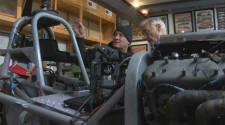The mention of stem cell therapy is guaranteed to draw horrified reactions from those who know nothing about the subject. Most of us have been informed that stem cells are harvested from a human embryo which is destroyed in the process. But the fact is that these therapies as practiced with resounding success in Germany, Mexico, and Panama, are based on the use of adult stem cells harvested from the patient's own bone marrow and blood. There is a very good reason for this, far removed from the ethical constrictions revolving around fetal cells. For the most practical of considerations, fetal stem cells are very poor weapons against any disorder in that they are excellent producers of their own disease – cancer. Fetal cells divide so rapidly, that the risk of cancer is very high, making them largely unsuitable for therapeutic uses.
INCURABLES CURED.
The list of diseases formerly thought to be incurable, and now being routinely cured with this therapy is impressive and extensive:
- ALS
- Alzheimer's Disease
- Autism
- Cardiovascular Diseases
- Cerebral Palsy
- Diabetes
- Failed Back Surgery Syndrome
- Macular Degeneration
- Multiple Sclerosis
- Osteoarthritis
- Rheumatoid Arthritis
- Parkinson's Disease
- Spinal Cord Injuries
- Stroke
The theoretical justification for the approach to adult stem cell therapy is based on solid science. All human life begins with an ovum and a sperm. Cells then arise in the fertilized ovum, which after a few days in the womb develop into embryonic stem cells. These cells are very unspecialized and possess the ability to develop into all of the 220 human cell types. A whole human being cannot develop from these cells as they are. They need to continue their development in the womb until they change into mature, differentiated cells which then take over a specific function of the body.
Throughout our lives however, we have cells that remain very unspecialized. The renewal of our skin, for example, is an ongoing process and continues until we die. Injuries heal. Hair grows. We live with cells which are very unspecialized, can continue to divide as we go through life and help our body to regenerate and repair itself. These are the cells used in adult stem cell therapy. Adult cells have been, and continue to be found in just about every body tissue; the hair, the brain, the liver, the blood, the bone marrow, etc. If body tissue is damaged, these stem cells flock to the damaged area to repair it. This provides the body with its own repair system, and modern therapy is meant to exploit this process.
LIMITATIONS
This is not to say that it's all roses without the thorns. The mechanism that causes stem cells to perform their magic is a long way from being understood. While many patients enjoy dramatic improvement, and even cures, the identical treatment will have no effect on others. So it all becomes a gamble and points up the need for a great deal of further research. The messengers that implement the healing process have not been identified. The relationship of a patient's age to the number and quality of available stem cells continues to be a mystery.
Especially important for diseases that appear later in life is the question of cell viability and their ability to divide. At what point have the stem cells exhausted their healing power? Would early preventive withdrawal be beneficial? And then of course, there remains the question of handling and dealing with the embryonic stem cell controversy while continuing the vital research needed here.
Recognizing the critical need for advanced research in this important area, the California Institute for Regenerative Medicine, in August 2009, awarded nearly seven million dollars in multi-year grants to the University of California at Davis for R&D of adult stem cell therapies. With more than 125 scientists and physicians on its faculty, UC Davis has commenced constructing a new Institute for Regenerative Cures in Sacramento and the prospect of cures for many incurable diseases continues to come closer to reality.















